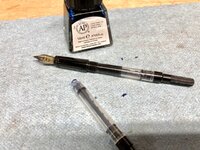Todd in PA
Member
Hi all. I'm super frustrated with the land of fountain pens. I'm new to this. Specifically, it's a "tac black (caballero) fountain pen.
 www.exoticblanks.com
www.exoticblanks.com
I popped the included SI-standard ink cartridge in and really enjoyed writing with it. The ink ran out. New adventure— I bought a bottle of blue ink at Michael's and tried the converter. Plunged the nib, twisted the plunger and sucked up some ink. It won't write. Rinse. Repeat. Repeat. Repeat. I thought maybe I was getting a vacuum holding the ink in, so I tried to press out all the air, but I'm pretty sure the nib is designed to prevent an air lock. I grabbed a new converter for another pen. Same result. Is there something I'm missing? Is there dried ink somewhere in the nib from the SIS that I gotta clean out?
For cleaning, do I just soak the whole nib in DNA? Or nib and section?
Tac Black Fountain Pen Kit - Black Chrome
This stylish and sleek fountain pen kit is an entry into our new Tactical pen kit series. This kit features all black hardware, plated in black chrome known for its beauty and durability. Making it the perfect choice for anyone serving in the military or working as a first responder.The fountain...
I popped the included SI-standard ink cartridge in and really enjoyed writing with it. The ink ran out. New adventure— I bought a bottle of blue ink at Michael's and tried the converter. Plunged the nib, twisted the plunger and sucked up some ink. It won't write. Rinse. Repeat. Repeat. Repeat. I thought maybe I was getting a vacuum holding the ink in, so I tried to press out all the air, but I'm pretty sure the nib is designed to prevent an air lock. I grabbed a new converter for another pen. Same result. Is there something I'm missing? Is there dried ink somewhere in the nib from the SIS that I gotta clean out?
For cleaning, do I just soak the whole nib in DNA? Or nib and section?

